Contributed Paper Session (CPS)
As a prominent agency within Malaysia's Statistical System, DOSM is committed to providing accurate and comparable statistical production and services to both the national and global statistical community. This role encourages to increase DOSM's involvement and impact on a global scale, promoting the exchange of expertise and experiences. The ISI WSC platform is a pioneer in strengthening the competency, expertise, and capability of DOSM officers. We offer our findings to global communities for improvement through discussions and deliberations.
In line with DOSM's vision of being the leader in statistical services to promote universal well-being and achieve the global 2030 agenda, we are pleased to offer on-going support to the Congress organisation. We are excited to share that we will be attending this year's congress in person, where we will have the opportunity to learn from and be inspired by the lessons and cultures of other countries. DOSM is proud to support and welcome this congress, and we will be presenting five research papers in the Contributed Paper Session (CPS) with the help of our 15 officers.
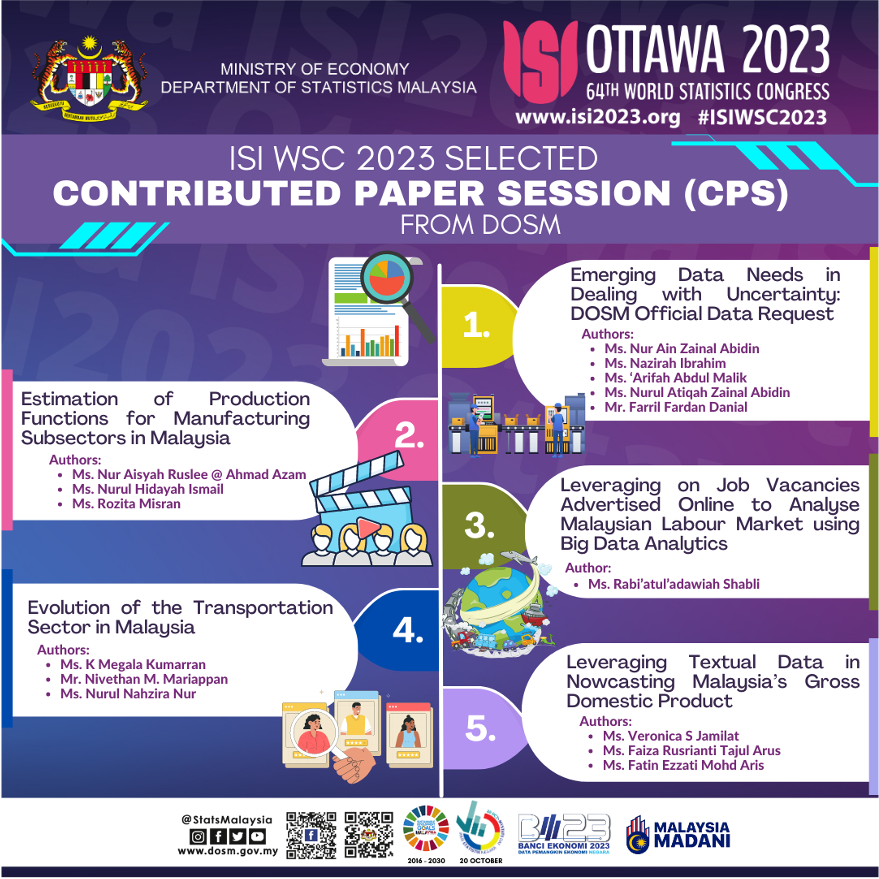
1. Emerging Data Needs in Dealing with Uncertainty: DOSM Official Data Request
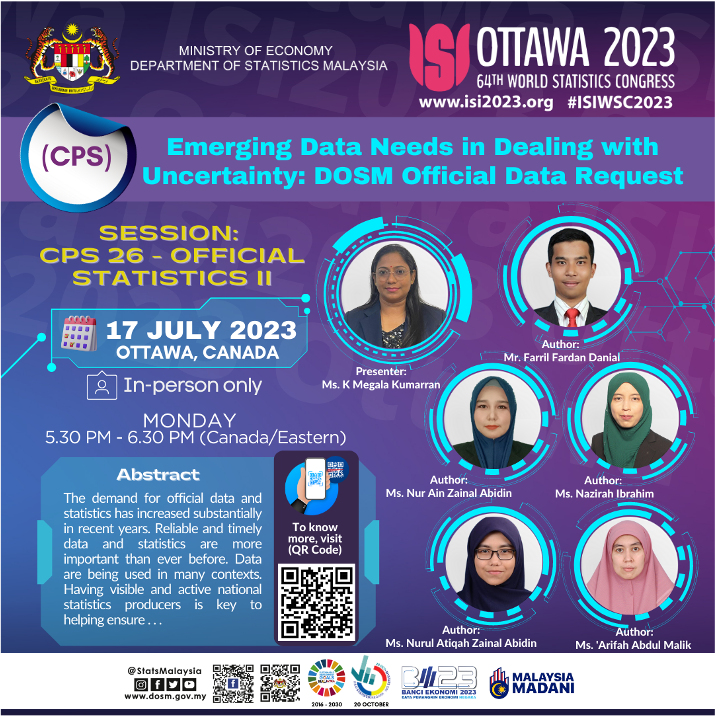
Abstract:
The demand for official data and statistics has increased substantially in recent years. Reliable and timely data and statistics are more important than ever before. Data are being used in many contexts. Having visible and active national statistics producers is key to helping ensure that the public receives information that is reliable and can be used for informed decision-making. The COVID-19 pandemic has turned into the world's largest collective learning exercise ever. Global collaboration underpins this momentum. Perhaps most obvious is scientific collaboration, where governments and universities share research publicly on the impact of the pandemic on the world. The pandemic has pushed more users to be aware of the importance of data critical to survival in this crisis. The Department of Statistics Malaysia (DOSM), the national statistical organization, has been instrumental in Malaysia’s development planning process for the last seven decades. To understand and overcome the phenomenon related to this unprecedented crisis caused by the coronavirus infectious disease (COVID-19), the importance of data exchange and sharing across fields has gained social attention. Policymakers need data to react to the crisis. Data and data sharing management including ad-hoc data, administrative systems and existing sources become very important in times of crisis. This study examines the changes that occurred in the pattern of DOSM data requested before, during and after COVID-19 due to the COVID-19 pandemic. Based on Malaysia’s scenario the number of data requests increased from the year 2019 to 2021 throughout the COVID-19 pandemic, forcing the country and government to look more seriously at various issues that are affected.
To know more, visit https://www.isi2023.org/abstracts/submission/759/view/
2. Estimation of Production Functions for Manufacturing Subsectors in Malaysia
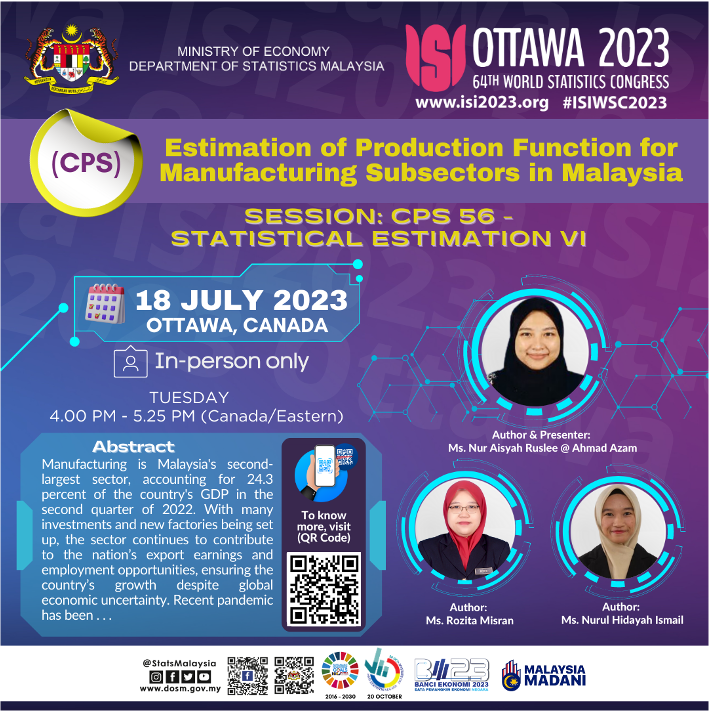
Abstract:
Manufacturing is Malaysia's second-largest sector, accounting for 24.3 percent of the country's GDP in the second quarter of 2022. With many investments and new factories being set up, the sector continues to contribute to the nation’s export earnings and employment opportunities, ensuring the country’s growth despite global economic uncertainty. Recent pandemic has been a challenge to the country, leaving everyone to adapt to new standard’s, technology and digitalisation. As Malaysia approaches the digital economy and Industrial Revolution 4.0, the government need to drive the nation with the right input and resources such as capital and labour in order to maintain the manufacturing productivity. Hence, using Cobb-Douglas production function, this paper will study the significance of capital and labour for eight subsectors of the manufacturing industry in Malaysia and examine the relationship between labour, capital and output of the subsectors. Data from surveys by the Department of Statistics Malaysia will be used in this study and in order to estimate the production function, the Least Square (LS) and robustness check methods are used.
To know more, visit https://www.isi2023.org/abstracts/submission/761/view/
3. Leveraging on Job Vacancies Advertised Online to Analyse Malaysian Labour Market Using Big Data Analytics
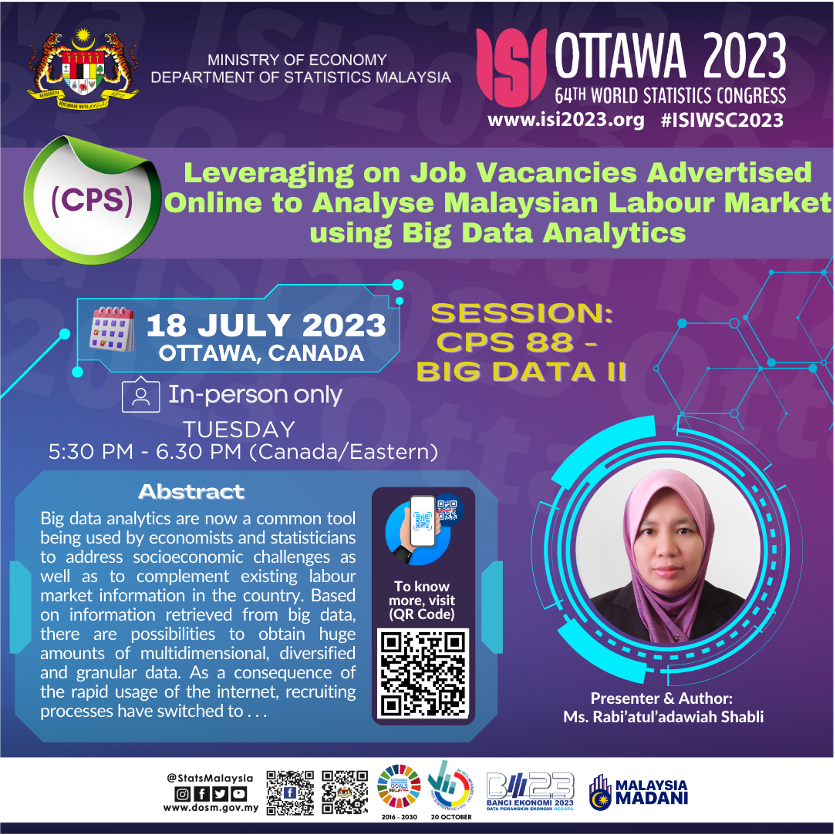
Abstract:
Big data analytics are now a common tool being used by economists and statisticians to address socioeconomic challenges as well as to complement existing labour market information in the country. Based on information retrieved from big data, there are possibilities to obtain huge amounts of multidimensional, diversified and granular data. As a consequence of the rapid usage of the internet, recruiting processes have switched to online applications and as a result, provide accessibility to vacancies data. The aim of this paper is to examine data gathered from job vacancies advertised online for the use of research in labour economics and skills development. Although extracted real-time, the processed data is available on a quarterly basis. In this paper, the information is analysed using several methods, namely descriptive analysis and time-series analysis. In addition, this paper assesses the main characteristics of the labour market data based on scraped vacancies data starting from the first quarter of 2020.
To know more, visit https://www.isi2023.org/abstracts/submission/769/view/
4. Evolution of the Transportation Sector in Malaysia
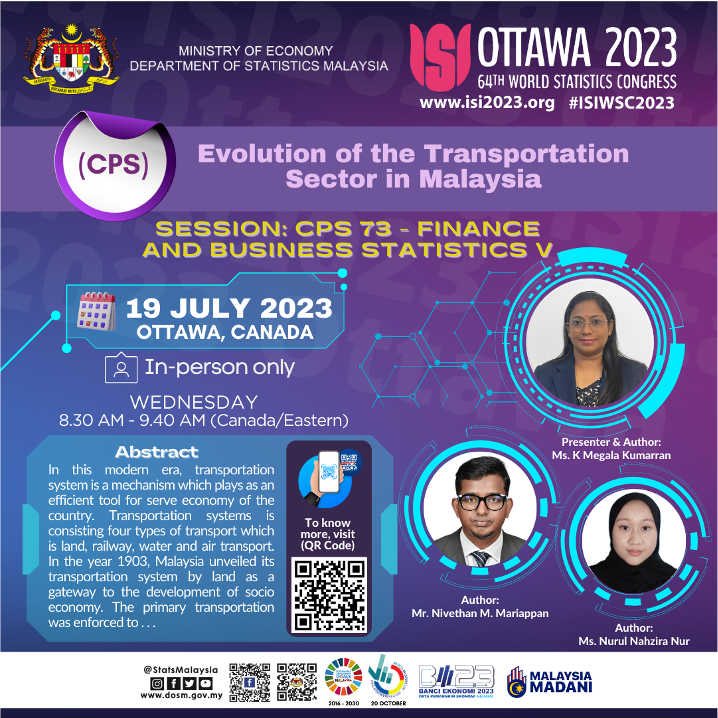
Abstract:
In this modern era, transportation system is a mechanism which plays as an efficient tool for serve economy of the country. Transportation systems is consisting four types of transport which is land, railway, water and air transport. In the year 1903, Malaysia unveiled its transportation system by land as a gateway to the development of socio economy. The primary transportation was enforced to interact with the involving larger cities in the rubber and tin mines. Now, with the evolution of transportation system, we could see railway system in Malaysia has expanded from steam train in the beginning to electric train in Keretapi Tanah Melayu Berhad (KTMB). Furthermore, now Malaysian government working with the Singapore government with East Cost Railway Link (ECRL), a mega project, where both countries can be concentrated by land and the project expected to be completed in the year 2027. As we talk about Malaysia Gross Domestic Product (GDP) 2021, the main contributor is the sector which contributed about 57.0 per cent. As we zoomed into services sector, the transportation sub-sector is the third largest contributor for Malaysia GDP. The transportation sub-sector amounted RM42.7 million (3.1%) to the services sector. Therefore, this paper aims to analyse the growth, progress, and the evolution of transportation system for the past and the revert 10 years.
To know more, visit https://www.isi2023.org/abstracts/submission/787/view/
5. Leveraging Textual Data in Nowcasting Malaysia’s Gross Domestic Product
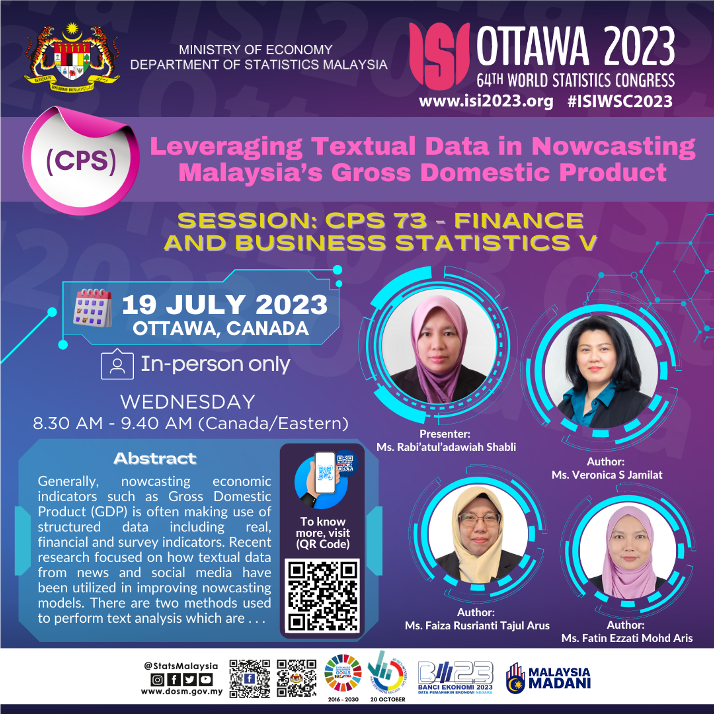
Abstract:
Generally, nowcasting economic indicators such as Gross Domestic Product (GDP) is often making use of structured data including real, financial and survey indicators. Recent research focused on how textual data from news and social media have been utilized in improving nowcasting models. There are two methods used to perform text analysis which are machine learning methods and lexicon-based methods. In this paper, we consider online news sentiment analysis as an additional data source into the recent work of nowcasting Malaysia’s GDP using Machine Learning. This paper performed both machine learning and Lexicon-based sentiment analysis to capture news sentiment on economic activities, i.e. Valence Aware Dictionary and Sentiment Reasoner (VADER), Maximum Entropy and SparkNLP. XGboost with sentiment analysis using SparkNLP found to perform better in nowcasting Malaysia's GDP.
To know more, visit https://www.isi2023.org/abstracts/submission/754/view/